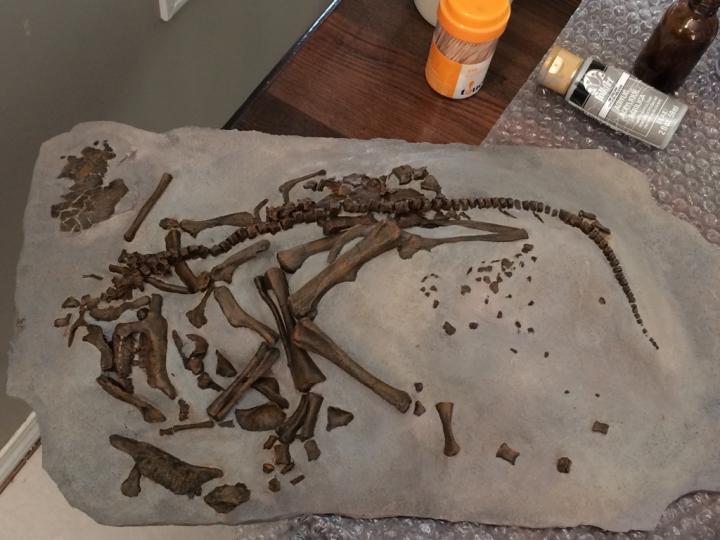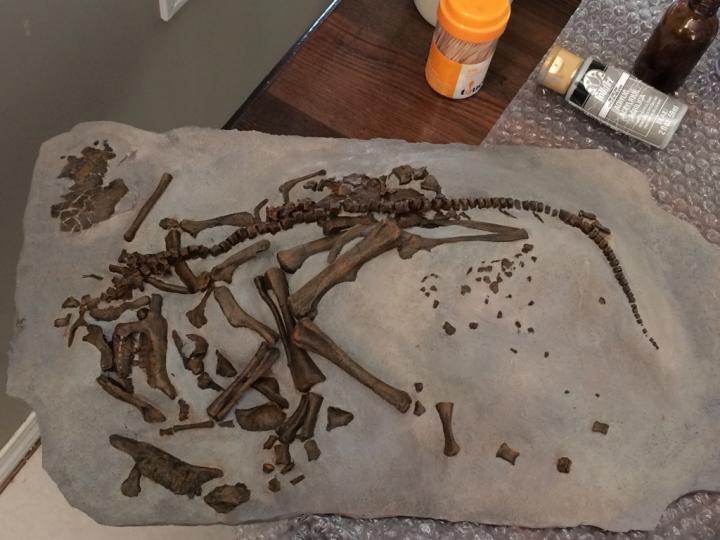
Credit: Courtesy of Darla Zelinitsky
TALLAHASSEE, Fla. — A human typically gives birth after nine months. An ostrich hatchling emerges from its egg after 42 days. But how long did it take for a baby dinosaur to incubate?
Groundbreaking research led by a Florida State University professor establishes a timeline of anywhere from three to six months depending on the dinosaur.
In an article in the Proceedings of the National Academy of Sciences, FSU Professor of Biological Science Gregory Erickson and a team of researchers break down the complicated biology of these prehistoric creatures and explain how embryonic dental records solved the mystery of how long dinosaurs incubated their eggs.
"Some of the greatest riddles about dinosaurs pertain to their embryology — virtually nothing is known," Erickson said. "Did their eggs incubate slowly like their reptilian cousins — crocodilians and lizards? Or rapidly like living dinosaurs — the birds?"
Scientists had long theorized that dinosaur incubation duration was similar to birds, whose eggs hatch in periods ranging from 11-85 days. Comparable-sized reptilian eggs typically take twice as long — weeks to many months.
Because the eggs of dinosaurs were so large — some were about 4 kilograms or the size of a volleyball — scientists believed they must have experienced rapid incubation with birds inheriting that characteristic from their dinosaur ancestors.
Erickson, FSU graduate student David Kay and colleagues from University of Calgary and the American Museum of Natural History decided to put these theories to the test.
To do that, they accessed some rare fossils — those of dinosaur embryos.
"Time within the egg is a crucial part of development, but this earliest growth stage is poorly known because dinosaur embryos are rare," said co-author Darla Zelenitsky, assistant professor of geoscience at University of Calgary. "Embryos can potentially tell us how dinosaurs developed and grew very early on in life and if they are more similar to birds or reptiles in these respects."
The two types of dinosaur embryos researchers examined were those from Protoceratops — a sheep-sized dinosaur found in the Mongolian Gobi Desert whose eggs were quite small (194 grams) — and Hypacrosaurus, an enormous duck-billed dinosaur found in Alberta, Canada with eggs weighing more than 4 kilograms.
Erickson and his team ran the embryonic jaws through a CT scanner to visualize the forming dentition. Then, they extracted several of the teeth to further examine them under sophisticated microscopes.
Researchers found what they were looking for on those microscope slides. Growth lines on the teeth showed researchers precisely how long the dinosaurs had been growing in the eggs.
"These are the lines that are laid down when any animal's teeth develops," Erickson said. "They're kind of like tree rings, but they're put down daily. We could literally count them to see how long each dinosaur had been developing."
Their results showed nearly three months for the tiny Protoceratops embryos and six months for those from the giant Hypacrosaurus.
"Dinosaur embryos are some of the best fossils in the world," said Mark Norell, Macaulay Curator for the American Museum of Natural History and a co-author on the study. "Here, we used spectacular fossils specimens collected by American Museum expeditions to the Gobi Desert, coupled them with new technology and new ideas, leading us to discover something truly novel about dinosaurs."
The implications of long dinosaur incubation are considerable.
In addition to finding that dinosaur incubation was similar to primitive reptiles, the researchers could infer many aspects of dinosaurian biology from the results.
Prolonged incubation put eggs and their parents at risk from predators, starvation and other environmental risk factors. And theories that some dinosaurs nested in the more temperate lower latitude of Canada and then traveled to the Arctic during the summer now seem unlikely given the time frame for hatching and migration.
The biggest ramification from the study, however, relates to the extinction of dinosaurs. Given that these warm-blooded creatures required considerable resources to reach adult size, took more than a year to mature and had slow incubation times, they would have been at a distinct disadvantage compared to other animals that survived the extinction event.
"We suspect our findings have implications for understanding why dinosaurs went extinct at the end of the Cretaceous period, whereas amphibians, birds, mammals and other reptiles made it through and prospered," Erickson said.
###
This research was supported by the National Science Foundation.
Media Contact
Kathleen Haughney
[email protected]
850-644-1489
@floridastate
http://www.fsu.edu
############
Story Source: Materials provided by Scienmag





